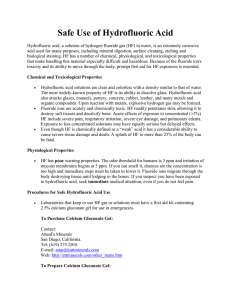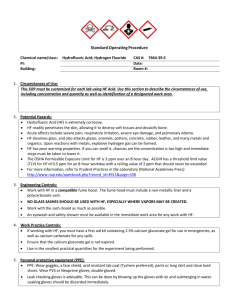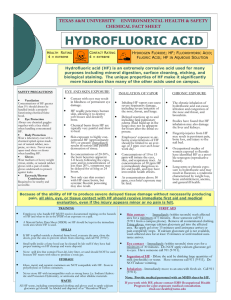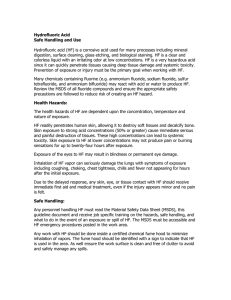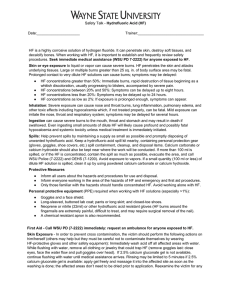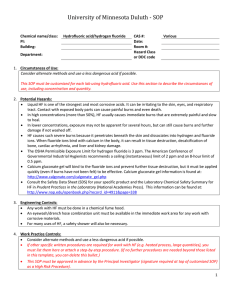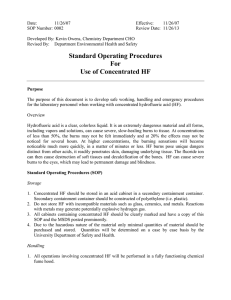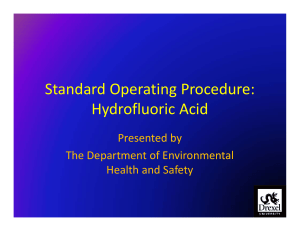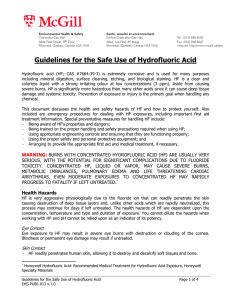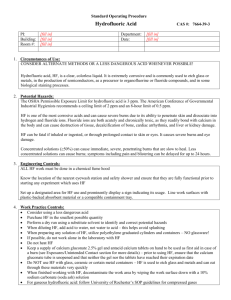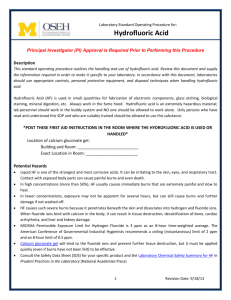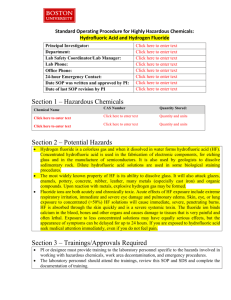HF SOP
advertisement
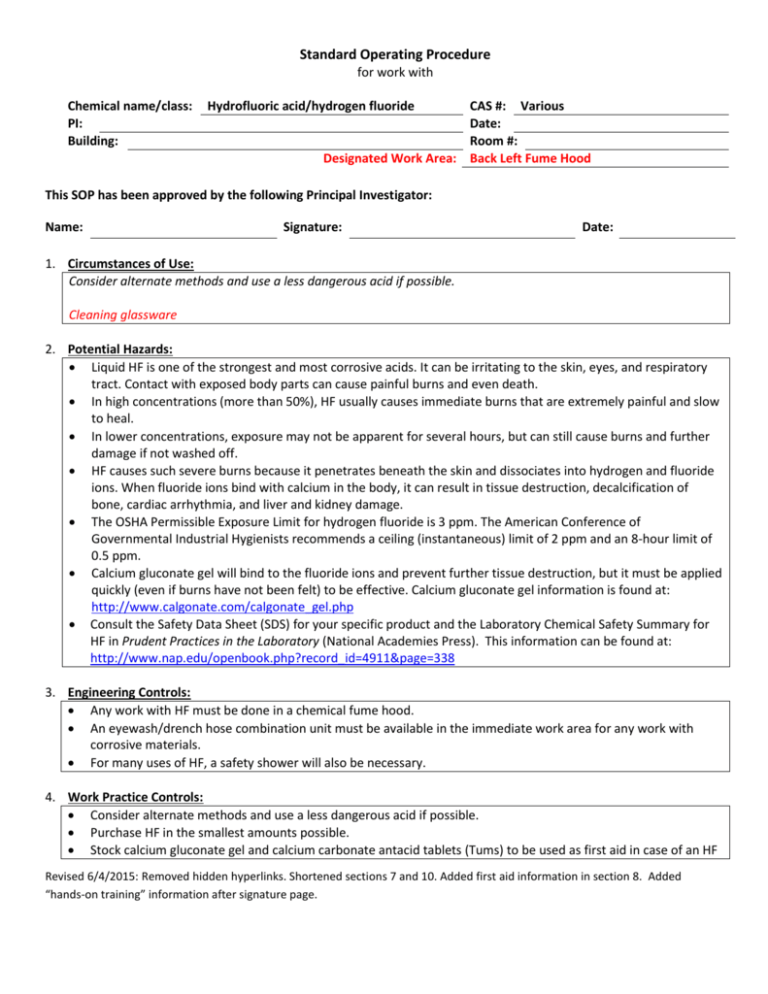
Standard Operating Procedure for work with Chemical name/class: PI: Building: Hydrofluoric acid/hydrogen fluoride CAS #: Various Date: Room #: Designated Work Area: Back Left Fume Hood This SOP has been approved by the following Principal Investigator: Name: Signature: Date: 1. Circumstances of Use: Consider alternate methods and use a less dangerous acid if possible. Cleaning glassware 2. Potential Hazards: Liquid HF is one of the strongest and most corrosive acids. It can be irritating to the skin, eyes, and respiratory tract. Contact with exposed body parts can cause painful burns and even death. In high concentrations (more than 50%), HF usually causes immediate burns that are extremely painful and slow to heal. In lower concentrations, exposure may not be apparent for several hours, but can still cause burns and further damage if not washed off. HF causes such severe burns because it penetrates beneath the skin and dissociates into hydrogen and fluoride ions. When fluoride ions bind with calcium in the body, it can result in tissue destruction, decalcification of bone, cardiac arrhythmia, and liver and kidney damage. The OSHA Permissible Exposure Limit for hydrogen fluoride is 3 ppm. The American Conference of Governmental Industrial Hygienists recommends a ceiling (instantaneous) limit of 2 ppm and an 8-hour limit of 0.5 ppm. Calcium gluconate gel will bind to the fluoride ions and prevent further tissue destruction, but it must be applied quickly (even if burns have not been felt) to be effective. Calcium gluconate gel information is found at: http://www.calgonate.com/calgonate_gel.php Consult the Safety Data Sheet (SDS) for your specific product and the Laboratory Chemical Safety Summary for HF in Prudent Practices in the Laboratory (National Academies Press). This information can be found at: http://www.nap.edu/openbook.php?record_id=4911&page=338 3. Engineering Controls: Any work with HF must be done in a chemical fume hood. An eyewash/drench hose combination unit must be available in the immediate work area for any work with corrosive materials. For many uses of HF, a safety shower will also be necessary. 4. Work Practice Controls: Consider alternate methods and use a less dangerous acid if possible. Purchase HF in the smallest amounts possible. Stock calcium gluconate gel and calcium carbonate antacid tablets (Tums) to be used as first aid in case of an HF Revised 6/4/2015: Removed hidden hyperlinks. Shortened sections 7 and 10. Added first aid information in section 8. Added “hands-on training” information after signature page. burn. (Medical attention should still be sought immediately for HF burns.) Prior to using HF, make sure the calcium gluconate tube is unopened and that neither the gel nor the tablets have reached their expiration date. Do not heat hydrofluoric acid. Do not use glass, ceramic, or other incompatible containers for HF. Perform a dry run to identify and correct potential hazards. Add acid to water, not water to acid. Work within sight and/or hearing of at least one other person who is familiar with the hazards and written procedures. Set up a designated area for HF use and post a warning sign during use. Post a sign at the door to the room when HF is in use. Line work surfaces with plastic-backed absorbent paper and/or a containment tray of compatible material. Once work with HF is complete, decontaminate the area by wiping it down with a 10% sodium carbonate (Na2CO3, also known as soda ash) solution. Gas hydrogen fluoride: Follow SOP for compressed gas guidelines. If you have any HF in lecture bottles, be aware that it can be extremely dangerous. 5. Personal protective equipment (PPE): Wear a fully buttoned lab coat with sleeves extended to wrists, face shield AND safety goggles, neoprene outer gloves and nitrile inner gloves, long pants (or other clothing covering the entire leg), rubber apron, and closed toed shoes. For small amounts of HF (<50 ml), double nitrile gloves can be used but must be changed immediately if splashed or thought to be contaminated. 6. Transportation and Storage: Transport corrosives in secondary containment, preferably a polyethylene or other non-reactive acid/solvent bottle carrier. Liquid hydrofluoric acid: Store in a compatible container (preferably polyethylene). HF reacts with glass, ceramics, and some metals. Place it in a compatible secondary container to capture leaks or spills. Store with other inorganic acids, away from bases and other incompatibles including metal (unless the metal has a corrosion-proof coating), and do not store under the sink. Avoid storing on the floor. Liquid or gas: Store in well-ventilated areas. Store below eye level. Store away from incompatibles. 7. Waste Disposal: Dispose as chemical waste. 8. Exposures/Unintended contact: Immediate first aid and medical treatment following these guidelines http://www.safety.duke.edu/OHS/Documents/Hydrofluoric_Acid_FirstAid_Guidelines.pdf is essential for people exposed to hydrofluoric acid. People working in areas where hydrofluoric acid is used should be familiar with these guidelines and they should be readily available (printed out) and kept with first aid supplies. A summary of first aid steps is included below but, when possible, refer to the guidelines at the link. Revised 6/4/2015: Removed hidden hyperlinks. Shortened sections 7 and 10. Added first aid information in section 8. Added “hands-on training” information after signature page. For an actual chemical exposure/injury Seek immediate medical attention at the emergency department for any HF exposure. Persons helping an exposed colleague must wear PPE as indicated above. Call CUFD at 911 or 656-2222 from a campus phone. For skin exposure: If using calcium gluconate gel, flush with water for 5 minutes then apply the gel by rubbing onto the burn site. Continue to massage the calcium gluconate gel into the burn site during transportation to a medical facility and while waiting to see a physician. The person applying the calcium gluconate gel should wear gloves to prevent a secondary HF burn. Use surgical gloves if available or neoprene over nitrile. If not using calcium gluconate gel, continue rinsing with water until medical treatment can be provided. For eye exposure: Flush eyes for at least 15 minutes with large amounts of gently flowing water. If sterile calcium gluconate solution (1%) is available, flushing eyes may be limited to 5 minutes, after which the calcium gluconate solution (1%) should be used repeatedly to irrigate the eye using a syringe. Take the victim to a doctor, preferably an eye specialist, as soon as possible. Use ice water compresses on the eyes during transportation. For ingestion, administer a calcium-containing medication (such as Tums) if available. Magnesium-containing stomach medication or several glasses of milk may also be given. Get immediate medical attention. Notify your supervisor and, within 24 hours, fill out the report of work-related accident, injury, or illness 9. Spill Procedure: Spills of HF in the fume hood (<5 ml) can be absorbed using magnesium sulfate, soda lime, sodium carbonate (Na2CO3), or other spill absorbent specified for HF. Do NOT use organic spill kits that contain Floor-Dri, kitty litter, or sand because HF reacts with silica to produce silicon tetrafluoride (a toxic gas). After spill has been completely absorbed, wipe down spill site with 10% sodium carbonate solution. 10. Training of personnel: Training on the lab-specific procedures must be performed by the PI or knowledgeable designee for all personnel working with HF and must be documented (including date, employee names, signatures, and topics covered such as location of calcium gluconate gel in the lab). “I have read and understand this SOP. I agree to fully adhere to its requirements. By signing below, I also acknowledge that I have received lab-specific training for use of this chemical.” Last First Clemson ID Signature Date Revised 6/4/2015: Removed hidden hyperlinks. Shortened sections 7 and 10. Added first aid information in section 8. Added “hands-on training” information after signature page.
